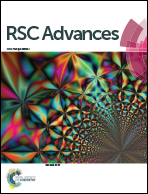Anti-corrosion porous RuO2/NbC anodes for the electrochemical oxidation of phenol†
Abstract
Efficient anode materials with porous structures have drawn increasing attention due to their high specific surface area, which can compensate for the slow reaction rate of electrochemical oxidation. However, the use of these materials is often limited due to their poor corrosion resistance. Herein, we report a facile scale-up method, by carbothermal reduction, for the preparation of porous niobium carbide to be used as an anode for the electrochemical oxidation of phenol in water. No niobium ions were detected when the anodes were under aggressive attack by sulfuric acid and under electrochemical corrosion tests with a current density less than 20.98 mA cm−2. The porous niobium carbide was further modified by applying a ruthenium oxide coating to improve its catalytic activity. The removal rates of phenol and chemical oxygen demand by the RuO2/NbC anode reached 1.87 × 10−2 mg min−1 cm−2 and 6.33 × 10−2 mg min−1 cm−2, respectively. The average current efficiency was 85.2%. Thus, an anti-corrosion, highly catalytically active and energy-efficient porous RuO2/NbC anode for the degradation of aqueous phenol in wastewater was successfully prepared.



 Please wait while we load your content...
Please wait while we load your content...